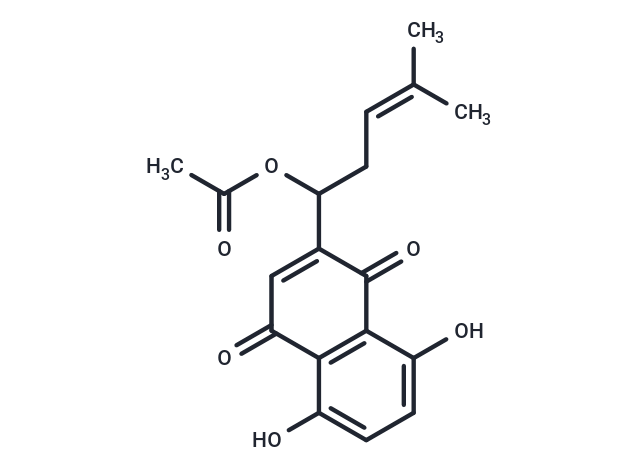Shopping Cart
- Remove All
 Your shopping cart is currently empty
Your shopping cart is currently empty

Acetylshikonin can effectively inhibit tumor cells, it can be used to treat hepatocellular carcinoma cells expressing hepatitis B virus X protein (HBX) by inducing ER stress , an oncoprotein from hepatitis B virus. Acetylshikonin inhibits the production of eicosanoid, is due to the attenuation of cytosolic phospholipase A(2) membrane recruitment via the decrease in [Ca(2+)](i) and to the blockade of cyclooxygenase and 5-lipoxygenase activity.

| Pack Size | Price | Availability | Quantity |
|---|---|---|---|
| 25 mg | $497 | Backorder |
| Description | Acetylshikonin can effectively inhibit tumor cells, it can be used to treat hepatocellular carcinoma cells expressing hepatitis B virus X protein (HBX) by inducing ER stress , an oncoprotein from hepatitis B virus. Acetylshikonin inhibits the production of eicosanoid, is due to the attenuation of cytosolic phospholipase A(2) membrane recruitment via the decrease in [Ca(2+)](i) and to the blockade of cyclooxygenase and 5-lipoxygenase activity. |
| In vitro | Lithospermum erythrorhizon has been used for treatment of inflammatory diseases and cancer as a folk remedy. Based on the evidences that anti-inflammatory agents frequently exert antiangiogenic activity, thus we examined comparatively the antiangiogenic activities of three naphthoquinone derivatives (shikonin, Acetylshikonin, and isobutyroylshikonin) isolated from the plant. METHODS AND RESULTS:Three derivatives exhibited weak cytotoxicity against human umbilical vein endothelial cells (HUVECs) with IC50 of over 20 microM. Shikonin had more specific inhibitory effects on proliferation and vascular endothelial growth factor (VEGF) production by VEGF compared with different derivatives. All of derivatives significantly suppressed the migration of VEGF treated HUVECs at different optimal concentrations. Also, shikonin and Acetylshikonin significantly disrupted VEGF-induced tube formation. Furthermore, three derivatives effectively downregulated the expression of urokinase-type plasminogen activator (uPA), but not its receptor uPAR. Additionally, shikonin significantly inhibited tumor growth in LLC-bearing mice, whereas its derivatives had relatively mild effects. CONCLUSIONS:Taken together, our findings suggest that shikonin and its derivatives exhibit the antiangiogenic and antitumorigenic effects by suppressing proliferation and angiogenic factors. |
| Molecular Weight | 330.33 |
| Formula | C18H18O6 |
| Cas No. | 54984-93-9 |
| Relative Density. | 1.326 g/cm3 (Predicted) |
| Storage | Powder: -20°C for 3 years | In solvent: -80°C for 1 year | Shipping with blue ice. |

Copyright © 2015-2025 TargetMol Chemicals Inc. All Rights Reserved.